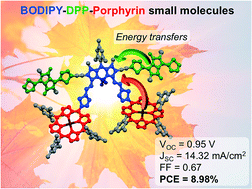BODIPY–diketopyrrolopyrrole–porphyrin conjugate small molecules for use in bulk heterojunction solar cells†
Abstract
Two small molecules denoted as BD-pPor and BD-tPor composed of a central BODIPY core surrounded with two DPP and two porphyrin units have been designed and synthesized. In BD-pPor and BD-tPor, porphyrins are linked to the central BODIPY by phenyl and thiophene bridges, respectively. The optical and electrochemical properties were systematically investigated in order to employ them as donors along with PC71BM as an acceptor for solution processed bulk heterojunction organic solar cells. After the optimization of the active layer, the organic solar cells based on BD-pPor and BD-tPor exhibit overall power conversion efficiencies of 6.67% and 8.98% with an energy loss of 0.63 eV and 0.50 eV. The low value of energy loss for BD-tPor may be related to the low LUMO offset between the BD-tPor and PC71BM (0.31 eV) as compared to that between BD-pPor and PC71BM (0.36 eV). The low energy loss also leads to a higher value of open-circuit voltage for the BD-tPor based OSC than its BD-pPor counterpart, despite the slightly deeper HOMO energy level of BD-pPor. The enhanced values of Jsc and FF of the BD-tPor based OSCs may be related to the better exciton dissociation and charge transport, as confirmed from the PL spectra and charge carrier mobility. These results indicate that the combination of BODIPY, DPP and porphyrin in the same conjugate is very promising for small molecule organic solar cells.



 Please wait while we load your content...
Please wait while we load your content...